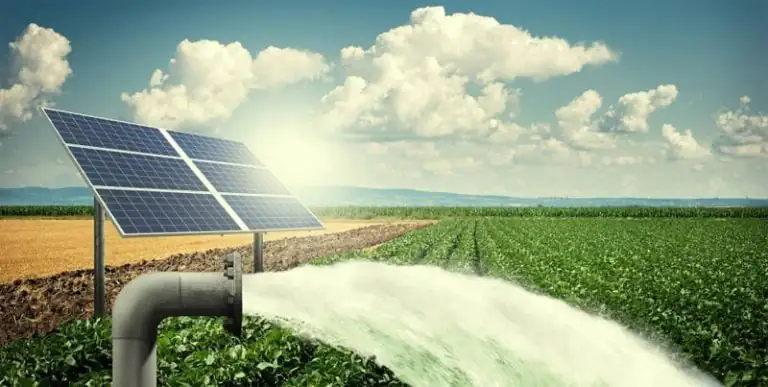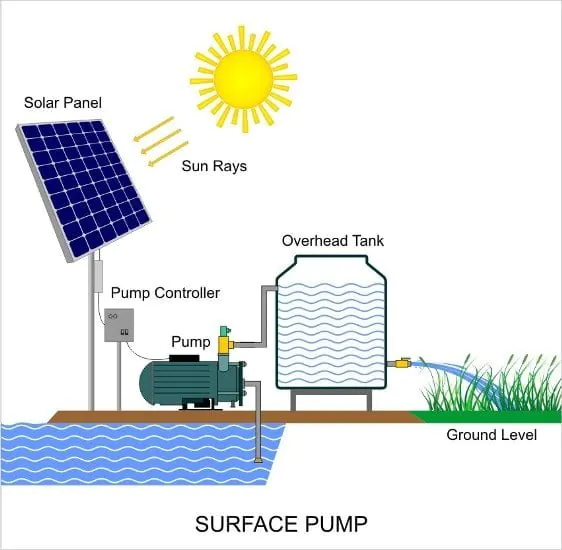2HP Solar Water Pump Price With Subsidy
1. What is a 2HP Solar Water Pump?

A 2HP solar water pump is a durable and energy-efficient device that pumps water using solar electricity. It is made up of a PV panel array, a controller, and a submersible pump. The PV panels capture solar and turn it into electricity, which powers the pump, which draws water from a source, such as a well or a body of water, and transports it to the desired position. These pumps are intended to provide a dependable and long-term solution for water pumping needs, particularly in places with limited access to electricity.
2. How Does a 2HP Solar Water Pump Work?
The conversion of solar energy into electrical energy is fundamental to the operation of a 2HP solar water pump. When sunlight strikes the PV panels, it excites the electrons, causing an electrical current to flow. This electrical energy is then routed to the controller, which manages the submersible pump's power supply. This electricity is used by the pump, which is submerged in the water source, to generate the necessary pressure to extract water and propel it through the delivery line to the desired position. The procedure is efficient, long-lasting, and environmentally beneficial.
3. Advantages of Using a 2HP Solar Water Pump
Using a 2HP solar water pump offers several significant advantages:
- Cost Savings: Solar energy is free and abundantly available, reducing or eliminating electricity costs for pumping water.
- Environmentally Friendly: Solar water pumps produce zero greenhouse gas emissions, contributing to a cleaner and greener environment.
- Reliability: With proper installation and maintenance, 2HP solar water pumps provide reliable operation even in remote areas without access to the power grid.
- Low Maintenance: These pumps have fewer moving parts, resulting in reduced maintenance requirements and costs.
- Scalability: 2HP solar water pumps can be easily expanded to meet increasing water demands by adding more PV panels or upgrading the system components.
- Long Lifespan: When properly maintained, a 2HP solar water pump can last for over 20 years, providing a long-term solution for water pumping needs.
4. Applications of 2HP Solar Water Pumps
2HP solar water pumps find applications in various sectors due to their versatility and efficiency. Some common applications include:
- Agricultural Irrigation: These pumps are widely used for irrigating crops, providing a sustainable water supply for farming operations.
- Livestock Watering: Solar water pumps ensure a constant and clean water supply for livestock in remote areas, eliminating the need for manual pumping or reliance on the power grid.
- Residential Water Supply: They can be used to supply water for domestic use, such as gardening, cleaning, and other household activities.
- Water Treatment and Distribution: Solar water pumps are employed in water treatment plants and distribution networks to ensure efficient water supply to communities.
- Aquaculture: They support the water circulation and aeration required for fish and shrimp farming, promoting a healthy aquatic environment.
2 HP Solar Pump Price
| Solar Water Pump | Selling Price | Price/HP |
| DC Submersible Solar Pump | Rs. 1,63,000 | Rs. 81,500 |
| AC Submersible Solar Pump | Rs. 1,51,000 | Rs. 75,500 |
| AC Surface Solar Pump | Rs. 1,35,000 | Rs. 67000 |
| DC Surface Solar Pump | Rs. 1,55,000 | Rs. 47,500 |
| 2 HP VFD Solar Solution | Rs. 95,000 | Rs. 47,500 |
| Hybrid 2 HP Solar Pump | Rs. 1,83,000 | Rs. 91,500 |
| 2 HP On-Grid Water Pump | Rs. 1,75,000 | Rs. 84,500 |
5. Factors to Consider When Choosing a 2HP Solar Water Pump
When selecting a 2HP solar water pump for your specific needs, it's essential to consider the following factors:
- Water Requirements: Determine the amount of water you need to pump and the desired flow rate to choose a pump with suitable specifications.
- Head Height: Measure the vertical distance between the water source and the intended delivery point to ensure the pump has sufficient head pressure capabilities.
- Sunlight Availability: Assess the solar irradiation levels in your location to determine the number and wattage of PV panels required for optimal performance.
- Water Source: Consider the type and depth of the water source, whether it's a well, borehole, or a surface water body, to select the appropriate pump type.
- System Components: Evaluate the quality and compatibility of the pump, controller, PV panels, and other system components to ensure seamless operation and longevity.
- Budget: Set a realistic budget and explore different options within your price range while considering the long-term cost savings offered by solar water pumps.
6. Installation and Setup of a 2HP Solar Water Pump

Installing a 2HP solar water pump requires careful planning and adherence to best practices. Here are the general steps involved in the installation process:
- Site Assessment: Evaluate the location for optimal sunlight exposure and proximity to the water source. Ensure there are no obstructions that can cast shadows on the PV panels.
- PV Panel Mounting: Install the PV panels on a sturdy and angled structure, such as a roof or a ground-mounted frame, to maximize solar energy absorption.
- Controller and Pump Setup: Connect the controller to the PV panels and the submersible pump according to the manufacturer's instructions. Ensure proper wiring and grounding.
- Water Delivery System: Lay out the delivery pipe from the pump to the desired location, considering the terrain, distance, and elevation changes. Use appropriate connectors and fittings.
- Electrical Connections: Connect the controller to the PV panels and the pump, following electrical safety guidelines and local regulations.
- System Testing: Perform a thorough test of the entire system to ensure proper functionality and water delivery. Monitor the pump performance and adjust settings if necessary.
It is recommended to consult a professional solar water pump installer for a seamless and efficient installation process.
7. Maintenance and Care for Your 2HP Solar Water Pump
To maximize the lifespan and performance of your 2HP solar water pump, regular maintenance and care are essential. Here are some maintenance tips:
- Cleaning PV Panels: Keep the PV panels clean and free from dust, debris, and bird droppings. Regularly wipe the surface with a soft cloth or use a gentle stream of water.
- Inspecting Wiring: Periodically check the wiring connections for any signs of damage or corrosion. Tighten loose connections and replace faulty wiring promptly.
- Monitoring Performance: Monitor the pump's performance, including water flow rate and pressure, to detect any anomalies or deviations. Consult a professional if needed.
- Protecting Against Freezing: In cold climates, take precautions to prevent freezing of water inside the pump and pipes. Insulate vulnerable components or drain the system if necessary.
- Battery Maintenance (if applicable): If your solar water pump has a battery backup system, follow the manufacturer's guidelines for battery maintenance, including regular checks and replacements if required.
- Professional Servicing: Schedule periodic servicing by a qualified technician to inspect and maintain the pump components, including seals, bearings, and motor.
By following these maintenance practices, you can ensure the longevity and optimal performance of your 2HP solar water pump.
8. Troubleshooting Common Issues with 2HP Solar Water Pumps
Even with regular maintenance, you may encounter occasional issues with your 2HP solar water pump. Here are some common problems and possible solutions:
- Insufficient Water Flow: Check for clogged filters or obstructions in the delivery pipe. Clean or replace the filters and remove any blockages.
- Low Water Pressure: Inspect the pump for air leaks or damaged seals. Replace faulty seals or seek professional assistance if needed.
- Inconsistent Pumping: Ensure the PV panels receive adequate sunlight. Check the controller settings and adjust as necessary.
- Motor Not Running: Verify the electrical connections and check the voltage supply to the pump. If the issue persists, contact a professional for motor inspection.
- Battery Backup Failure: If equipped with a battery backup, check the battery connections and charge level. Replace the battery if it no longer holds a charge.
- Abnormal Noise or Vibration: Inspect the pump for loose or damaged parts. Tighten connections and replace damaged components as required.
If you encounter persistent issues or are unsure about troubleshooting, consult a qualified technician to diagnose and resolve the problem.
